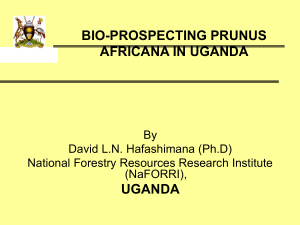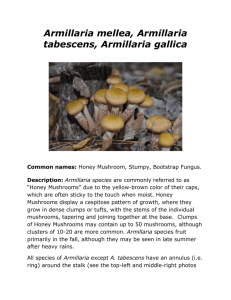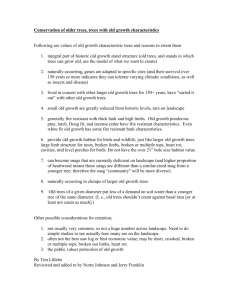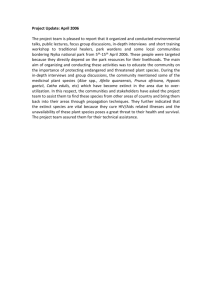Honey Fungus Plant Protection Services Honey Fungus Leaflet
advertisement
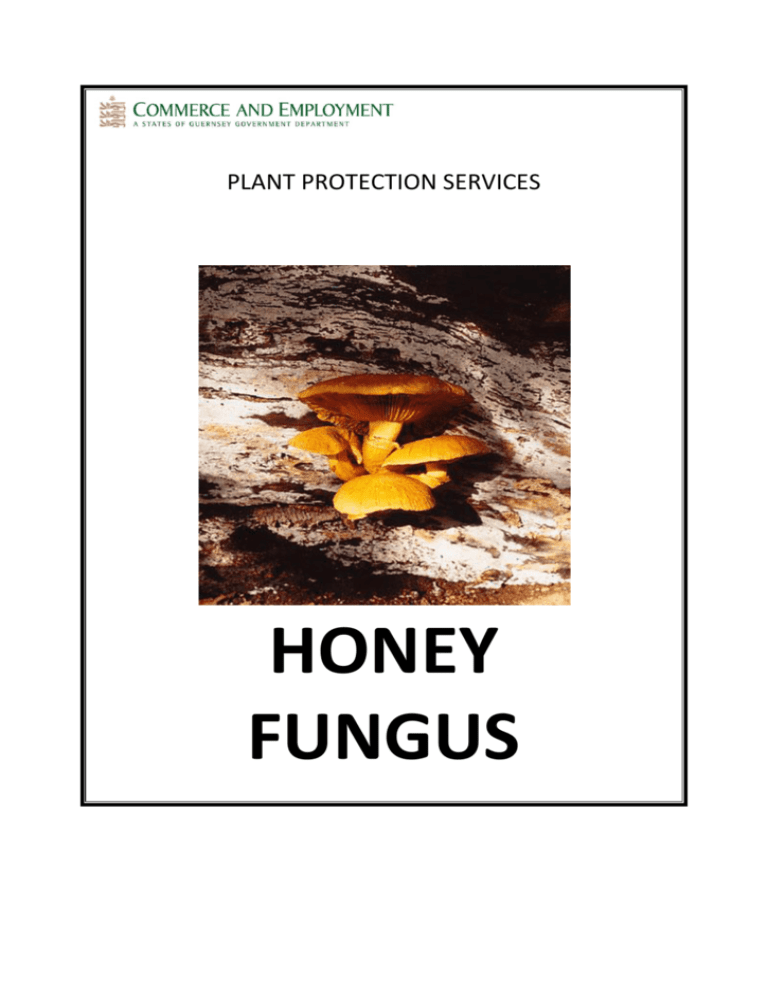
PLANT PROTECTION SERVICES HONEY FUNGUS HONEY FUNGUS Introduction Honey Fungus or Armillaria is probably the most important killer of woody plants on the Island. There has been some controversy in recent years about whether it is a serious parasite or a secondary invader. Honey Fungus used to be considered one species, Armillaria mellea, however recent research has shown that there are several species in the UK varying in their pathogenicity. Of the seven species found in Europe, some are highly parasitic causing serious plant disease whereas others are merely saprophytic living on dead wood. The seven species are:Armillaria mellea – serious pathogen can kill a wide range of broad-leaved and coniferous trees. This is the most common killer of garden trees and shrubs. Armillaria ostoyae – a species which is mostly restricted to conifers and can be a serious pathogen in a forest situation. Armillaria cepistipes – relatively benign and found mostly as a decomposer on dead wood. Armillaria borealis -mainly saprophytic on deciduous trees and conifers. A weak parasite of birch and wild cherry. Armillaria ectypa – Rare but found in marshland amongst Sphagnum moss. Armillaria tabescens – usually on wood of deciduous trees in Western Europe. Armillaria gallica- relatively benign. Sometimes found as a weak parasite of hardwoods. The main food base for the fungus is wood and, therefore, stumps, infected trees or woody debris are potentially hazardous. It has even been known to feed on the bases of untreated fence posts and can attack herbaceous plants such as potato and strawberry. We are often asked if the Honey Fungus can be spread by bark chips and whilst in theory this is possible, the Arboricultural Advisory and Information Services in the UK consider it to be extremely unlikely to happen if composted bark chips are used. Recent experiments by the RHS have demonstrated that infected bark chips can initiate infection but that the incidence was low. The size of the bark chip is also an important factor because larger pieces can sustain the fungus for a longer period of time which increases the risk of plant infection. It would be prudent not to use fresh bark chips and only use stocks that have been composted. Mode of Attack Armillaria can damage trees in two ways:1. By attacking and killing the conductive tissue under the bark and therefore the whole tree, this is a very obvious symptom of the first two species. The effect is similar to ring barking and the tree often produces abundant fruit or cones before it dies. 2 2. By causing an internal white rot the wood is weakened by the fungus breaking down lignin. The wood often becomes watersoaked but becomes brittle as it dries. Whilst this does not immediately kill the tree, it seriously weakens the wood and roots making the tree subject to wind throw and therefore dangerous. Symptoms The first indication that the disease is present is often the wilting of leaves followed by the rapid death of a tree or shrub e.g. Rhododendron. In some other plants decline in shoot growth, abnormally small leaves, a heavy crop of fruit or cones, or gradual dieback may be the first symptoms. In hedgerows a gradual progression of dead or dying plants is a good indication of Armillaria. Sometimes gummy or resinous exudations can be seen on infected tree trunks. Armillaria has three distinct stages, mycelial sheets, toadstools and rhizomorphs. 1. White Fan-Shaped Mycelium A white fan-shaped fungal or a ‘felty’ growth of mycelium will be seen just under the bark, running up the stem from soil level. These soft, white sheets are about paper-thick and the fan-shaped edge contrasts sharply with the bark and wood, a strong ‘mushroomy’ smell is noticeable when fresh. This fan-shaped mycelium, which penetrates the bark on the roots, crown or stem grows between wood and the bark, separating them. As it extends under the bark it eventually girdles the tree and kills it. It is this separation of bark from the underlying wood, combined with toxins excreted by the fungus into the water and nutrient bearing cells of the tree, which causes the death of the tree. This white fungal sheet is the best indicator of Armillaria. 2. Toadstools This is the reproductive stage of the fungus and each toadstool is capable of producing masses of spores, which may spread by wind over considerable distances. Whilst the spores are able to colonise stumps of recently felled trees, it rarely does, and the spores are of little danger to healthy trees. The toadstools appear in autumn (October-November) and will be seen on many of the Guernsey hedgerows. They are very variable in colour, size and shape but generally:Cap 3-15cm across, honey-brown colour with fine dark scales especially in the centre. Stem 60-150 x 5-15mm, tapering towards the base, or swollen, whitish becoming reddishbrown, and initially it has a whitish to yellow cottony ring. Gills Adnate to subdecurrent or distinctly decurrent (i.e. continue slightly down the stem), are white at first turning pale cream and may become darker and spotted with age. Flesh White, tastes astringent and has a strong smell. It is edible only when cooked. 3. Rhizomorphs 3 Rhizomorphs are usually produced during the terminal stages of decay. These are the structures that give the fungus the name Bootlace or Shoestring fungus and they are the main means of spread. They are long, black/brown, flat, root-like cords which may be seen growing out from the bark or roots. They are formed by the aggregation of fungal threads and they have a tough protective rind. Rhizomorphs are less branched than roots but grow in a similar manner from an infected stump through soil or surface litter and they may spread out several metres from the infected tree forming a web-like system. This web-like network survives as long as a sequence of food sources continues to be accessible. Rhizomorphs of some species are produced in waves, whilst others are long lived. Rhizomorphs vary in size from a millimetre in diameter to almost pencil thick. As no other British fungus produces rhizomorphs like this they are a good indicator that Armillaria is present. Recent research indicates the rhizomorph abundance varies with species and that rhizomorphs of the different species behave in different ways. The rhizomorphs of the more pathogenic species (A. mellea and A. ostoyae) do not need a wound to penetrate roots as they attach themselves to roots. The tip of the rhizomorph penetrates the bark scales either by mechanical force or by production of toxic substances. These species have less abundant, more fragile rhizomorphs than those of the less parasitic species. The less virulent species (A. cepistipes) need wounds to enter the roots and produce many tough rhizomorphs. These highly visible rhizomorphs are not so dangerous to healthy trees, although they will infect seriously injured ones whose damaged roots are biochemically predisposed to infection. With A. tabescens rhozomorphs are rare or absent. Rhizomorphs have been recorded as growing a metre per year, but growth rate correlated to size and type of the food source and to the substrate, with peat encouraging growth whilst sand inhibits it. Seasonal desiccation of upper soil levels governs the vertical distribution of the fungus, which is usually found 10-20 cm deep. Root Transmission There is one other way in which Armillaria spreads from plant to plant; this is by root to root contact. When infected roots meet in the soil, the fungus is able to spread into the other plant. Control There is no control of this disease once it has penetrated the plant as the major problem is getting sufficient control agents to the site whilst they are still active. Armillaria is well protected, producing antibiotics, thick walled fungal cells and pseudosclerotia which chemical or biological agents need to get past to control. Apart from fumigation, there is little evidence that most commonly advocated chemicals are effective. Cultural Control No woody plant is immune to the fungus but some trees resist infection, some become more resistant with age and sometimes the fungus only attacks part of a tree allowing it to survive for many years. Stress predisposes a tree to infection by Armillaria so it is important to ensure the trees/shrubs are given good growing conditions. Waterlogging, shading, light, drought, defoliation, advanced age, 4 declining vigour of the host plant, damage due to pollution, nutrient deficiency, insects and fungi etc, all affect the plant’s growth and can predispose the tree to infection. Whilst there is no totally effective chemical control of Armillaria at the present, there are various cultural measures you can take to prevent spread and to protect any new plantings. It is most important to remove the source of infection 1. As woody material is food for Armillaria, rhizomorphs usually radiate out from the infection. Armillaria may stay active for decades in very large stumps especially from hard wood stumps, so it is important that grubbing or chipping removes these sources of food. 2. Remove as many roots as possible, especially the larger ones. But remember to be careful when removing roots from around healthy trees, as damaging these roots will leave them open to infection by the less virulent Armillaria species and other soil pathogens. 3. Look for other infected plants in the area and remove these and their root systems. 4. In hedges remove one apparently healthy plant on either side of the dead ones, as these are probably infected by root contact, even if they are not showing symptoms. 5. As rhizomorphs need to be attached to their woody food in order to grow and spread, regular deep cultivation of the infected area for at least one year will also help control the spread of the disease. Cultivation breaks up the rhizomorphs and detaches them from their food source. However, remember Armillaria forms a web and can remain active as long as some of its rhizomorphs are attached to a woody food source, so can re-enter an area from any direction. If the site is suitable, planting annual bedding plants in the area for 1-3 years will help control the problem as annuals are unlikely to be infected by Armillaria. When preparing the soil for annuals, cultivate the soil to a depth of at least 30-45cm. When doing this you will break up any rhizomorphs present and detach them from their food source. Adding fertiliser and organic matter will also improve the soil structure and lead to healthy plant growth. Several years of this treatment will greatly improve the fertility of the soil and give resistant shrubs or trees a good chance of survival when you eventually replace them. 6. Leaving the infected area fallow for one or two years is another possibility but as the area is left uncultivated the rhizomorphs may still be viable. Improve the soil structure and fertility before re-planting with resistant shrubs or trees. 7. Some areas of the garden are not suitable for the above treatments, especially old hedge areas as here it is often essential to replace the hedging quickly. Apart from putting in a fence or wall, removing the contaminated soil and swapping it with soil from the vegetable garden before replanting is another alternative. Protection of Trees 5 If the above measures are impractical for your situation, then it may be worth considering protecting your other trees and shrubs by putting down a physical barrier. Physical barriers however are only useful for really valuable trees and if the source of Armillaria is known. Remember Armillaria often has a web of rhizomorphs and can attack from any direction. Barriers can be either:a) Heavy gauge polythene sheet. (The polythene sheet should also be inspected occasionally. b) Trenches. NB rhizomorphs can go deep so these barriers should be down at least 45cm (18 inches) in heavy soils and up to a metre in light ones and need to be re-dug annually. c) Deep cultivation. Rhizomorphs continue to grow until the food supply is exhausted so cultivations will have to be repeated regularly. Be very careful not to damage the roots or the tree you wish to protect. Resistant Plants If none of these control methods are feasible then plant resistant types of trees or shrubs. As Armillaria is a very successful fungus, it is unlikely that any woody plant is truly immune although grasses such as Bamboo and Pampas Grass are considered to be immune or highly resistant to the fungus so in areas of high infection these should be considered. Bamboo can make a good dense screen, although in certain conditions some varieties can be invasive. Regular cutting back will keep most under control and you will always have a ready supply of bamboo canes. Take advantage of the less invasive varieties currently available to fill a gap where Honey Fungus is endemic. Pampas grass can produce an impenetrable border and be less suitable for some areas, but it needs a border of at least 3m (3 yards) wide. Yew is one woody plant considered to be very resistant once it is established, but we have seen other fungal and cultural problems with this plant when it is young. However, given good soil conditions and careful watering this plant can make an effective hedge. A list of resistant and susceptible trees and shrubs can be found at the back of this leaflet. Other plants not mentioned in the list may also be suitable, but remember that as a general rule the faster the plant grows the more likely it is to succumb to Armillaria. It is the slower growing shrubs that resist the fungus. Many of the plants in this list are resistant enough to plant in infected areas. However, even resistant plants will succumb if growing conditions are poor and the plants are under stress. Young newly planted trees are also vulnerable especially if their roots are damaged. When planting new trees, cultivate the area thoroughly and give them the correct conditions (e.g. do not plant lime haters in calcareous soil or salt haters near the coast). Also, water regularly until the plants are fully established. Do not over-water as this can kill young feeding roots and encourage fungal entry. Biological Control 6 The use of green waste compost can reduce the ravages of Honey Fungus in two ways. Firstly, it can create a better growing environment for the plants by improving the soil structure and the water holding capacity of the soil. Stressed plants are more likely to succumb to the disease. Good quality green waste compost also contains a lot of beneficial bacteria and fungi which can be antagonistic towards Armillaria species. Chemical Control Currently there are no pesticides approved for the control of Honey Fungus. Since the reformulation of Armillatox it is no longer approved for the control of Armillaria and should not be used. Identification If you suspect an Armillaria infection in your garden plants follow these instructions and bring samples into the Plant Pathology Laboratory at Raymond Falla House. Visits can be made, but only on a chargeable basis. Either: Bring in the whole plant, if it is not too large! or: If the shrub is too big take samples of bark from just above soil level or a few pieces of roots (about the thickness of a finger) from near the stem, as this is usually where the fungus is found. It is important not only to bring in the correct type of sample but also to keep it fresh, so put the sample in a polythene bag. 7 HONEY FUNGUS LIST OF RESISTANT AND SUSCEPTIBLE PLANTS 2011 A – Annual FT – Frost Tender T – Tender D – Deciduous H – Fully Hardy E – Evergreen HH – Half Hardy FH – Frost Hardy SE – Semi Evergreen PROBABLY IMMUNE MONOCOTYLEDONS Arundinaria and related genera Cordaderia selloana Cordyline australis Nandina domestica Phormium spp Bamboo Pampas Grass New Zealand cabbage palm Heavenly or Sacred bamboo New Zealand Flax E/HH-H E/H HH E-SE-FH E/H Ash-leaved maple, Box elder Yew D/FH E/H PROBABLY HIGHLY RESISTANT TREES Acer negundo Taxus baccata RESISTANT Observations and records indicate that these plants are resistant to the disease under good conditions. They are not immune and can be infected by Armillaria. Poor growing conditions where plants are under stress (due to root damage, drought or waterlogging etc.) can result in infection. RESISTANT CLIMBERS Clematis species Hedera helix Lonicera periclymenum Polygonum baldschuanicum Clematis Common English ivy Common honeysuckle, Woodbine Russian vine D/SE/E/H E/H D/H D/H Glossy Abelia, White Abelia Common box Camellia Wintersweet Rock rose Fabiana Rose of Sharon, Shrubby Althea Crape myrtle Lonicera, Box honeysuckle Oregon grape Holly Mahonia Mahonia SE/FH E/H E/H D/FH E/FH-HH E/FH D/H D/FH E/H E/H-HH E/H E/H RESISTANT SHRUBS Abelia x grandiflora Buxus sempervirens Camellia species Chimonanthus praecox Cistus species Fabiana imbricata Hibiscus syriacus Lagerstroemia indica Lonicera nitida Mahonia species Mahonia aquifolium Mahonia japonica 8 Myrtus communis Myrtle E/FH Daisy bush E/FH E/FH E/FH-FT E/FH D/H E/H E/HH E/FH D/H E/H RESISTANT SHRUBS cont. Olearia macrodonia Olearia traversii Pittosporum species Prunus laurocerasus Prunus spinosa Pyracantha crenulata Rhaphiolepis indica Rhaphiolepis umbellata Shepherdia argentea Ulex europeaus Pittosporum Cherry laurel Blackthorn, Sloe Firethorn Indian hawthorn Yeddo hawthorn Buffalo berry Gorse, Furze RESISTANT HEDGING PLANTS Berberis species Berberis darwinii Berberis thunbergii Berberis wilsoniae Euonymus japonicus Ilex aquifolium Olearia macrodonta Olearia traversii Pittosporum toberia Quercus ilex Tamarix species Tamarix gallica Barberry Darwin’s Barberry Japanese Barberry Wilson Barberry Japanese spindle Common holly Daisy busy Japanese Pittosporium Mock orange Holm oak Tamarisk French tamarisk D/SE/E/H-FH E/H D/H D/SE/H E/FH E/H E/FH E/FH E/FH E/FH D/E/H-FH D/FH Silver fir White fir Giant fir Noble fir Firs Flowering maple Vine-leafed Abutilon Star/Whorl-leaved acacia Oregon maple California box elder Sycamore Tree of heaven Silk tree Madrona Paper mulberry Incense cedar Common hornbeam Indian bean tree E/H E/H E/H E/H E/H E/SE/FH-FT D/FH E/HH D/H D/H D/H D/H D/HH E/FH D/F E/H D/H D/H RESISTANT TREES Abies alba Abies concolor Abies grandis Abies procera Abies species Abutilon species Abutilon vitifolium Acacia verticillata Acer macrophyllum Acer negundo var. californicum Acer pseudoplatanus Ailanthus altissima Albizia julibrissin Arbutus menziesii Broussonetia papyrifera Calocededrus decurrens Carpinus betulus Catalpa bignoniodes 9 Celtis occidentalis Hackberry D/H Smoke tree Hawthorn Hawthorn, May Common Hawthorn Washington Thorn Gum tree Redbox, Australian beech Common beech Ash Common ash Common holly Junipers Golden-rain tree, Pride of India Larch Japanese larch European larch Dunkeld larch Sweet gum Tulip tree Magnolia Maiten Mulberry Southern beech Amur cork tree Chinese cork tree Chinese pistachio Plane London plane Poplar Cherry laurel Douglas fir Oaks Maul oak, Golden cup oak Sessile/Durmast oak Common, Pedunculate oak Sumach Stag’s-horn Sumach Locust Locust, False acacia Common elder Linden, lime Common lime Elm Chaste tree Japanese Zelkova D/H D/H D/H D/H D/H E/FH-FT E/FT D/H D/H D/H E/H E/H D/FH D/H D/H D/H D/H D/H D/H D/SE/E/HFH E/FH D/H D/H D/H D/H D/H D/H-FH D/H D/H E/FH E/H D/E/H-FH E/H D/H D/H D/H-HH D/H D/H D/H D/H D/H D/H D/H D/FH D/H RESISTANT TREES cont. Cotinus coggygria Crataegus species Crataegus laevigata Crataegus monogyny Crataegus phaenopyrum Eucalyptus species Eucalyptus polyanthemos Fagus sylvatica Fraxinus species Fraxinus excelsior Ilex aquifolium Juniperus species Koelreuteria paniculata Larix species Larix kaempferi Larix decidua Larix x eurolepis Liquidambar styraciflua Liriodendron tulipifera Magnolia species Maytenus boaria Morus species Notofagus species Phellodendron amurense Phellodendron chinense Pistacia chinensis Platanus species Platanus x acerifolia [hispanica]? Populus species Prunus laurocerasus Pseudotsuga menziesii Quercus species Quercus chrysolepis Quercus petraea Quercus robur Rhus species Rhus typhina Robinia species Robinia pseudoacacia Sambucus nigra Tilia species Tilia x europaea Ulmus species Vitex agnus-castus Zelkova serrata 10 RESISTANT FRUIT & NUTS Castanea dentata Castanea sativa Cydonia oblonga Diospyros kaki Diospyros lotus Diospyros virginiana Ficus carica Malus species Malus ioensis Malus prunifolia Malus cerasifera Prunus Americana Prunus avium Prunus insititia Prunus spinosa Prunus species Pyrus betulaefolia Pyrus calleryana Pyrus communis American chestnut Spanish/Sweet chestnut Quince Chinese persimmon Date plum Common persimmon Common fig Crab-apple Prairie Crab-apple Pear-leaf Crab-apple Cherry plum, Myrobalan American plum Sweet cherry St. Julien plum Blackthorn, Sloe Plum Birch-leaf pear Callery pear Pear D/H D/H D/H D/FH D/H D/H D/H D/H D/H D/H D/H D/H D/H D/H D/H D/H D/H D/H D/H SUSCEPTIBLE PLANTS These plants are liable to be infected by Honey Fungus and should not be planted in areas where Honey Fungus has been found. SUSCEPTIBLE CLIMBERS Humulus lupulus Hop H Butterfly bush Oxeye butterfly bush Orange butterfly bush Paradise Poinciana Weeping Bottlebrush Bluemist Ceanothus Blue-blossom Mexican orange blossom Franchet Cotoneaster Tree Cotoneaster Harrow Cotoneaster D/H D/H D/SE/H D/FH E/HH D/FH D/E/FH-HH E/FH E/FH D/SE/E/H-FH E/SE/H D/H E/H D/H SUSCEPTIBLE SHRUBS Buddleia davidii Buddleia davidii var. magnifica Buddleia globosa Caesalpina gilliesii Callistemon viminalis Caryopteris x clandonensis Ceanothus species Ceanothus thyrsiflorus Choisya ternata Cotoneaster species Cotoneaster franchetii Cotoneaster frigidus Cotoneaster harroviana Cotoneaster horizontalis Wall-spray 11 Cotoneaster microphylla Cotoneaster microphylla var. vellea Rock-spray Cotoneaster E/H E/H Silver-leaf Cotoneaster Hardy willow-leaf Cotoneaster Easter broom Fuzzy Deutzia Eleagnus Oleaster Heather Alpine heath, Winter heath Montevideo Escallonia Laurustinus E/SE/H E/HH E/H D/H D/E/H-FH D/H E/H-FH E/H E/H E/H D/H E/SE/FH D/E/FH-FT E/H-HH E/HH E/FH D/FH D/E/H-FT E-SE/FH H E/H D/H D/H-FH E/FH E/H E/H E/FH D/H E/SE/D/HFT D/SE/H D/FH D/H /SE/E/HFH E/FH Lawson cypress Leyland cypress Red Escallonia Golden Euonymus Privet Japanese privet Privet E/H E/H E/H E/H E/FH D/SE/E/HFH E/FH E/SE/H SUSCEPTIBLE SHRUBS cont. Cotoneaster pannosa Cotoneaster salicifolia var. floccosa Cytisus x spachianus Deutzia scabra Elaeagnus species Eleagnus angustifolia Erica species Erica carnea Escallonia montevidensis Escallonia pulverulenta Forsythia species Fremontodendron mexicanum Fuchsia species Hebe species Hebe andersonii Heteromeles arbutifolia Hydrangea macrophylla Hibiscus species Hypericum patulum cv. henryi Hypericum prolificum Juniperus species Kerria japonica Philadelphus species Pyracantha angustifolia Pyracantha coccinea Pyrancantha coccinea cv. lalendei Pyracantha rogersiana Rhus trilobata Rhododendron species Rosa species Spartium junceum Spiraea prunifolia Viburnum species Viburnum tinus Southern Fremontia Fuchsia Hebe Anderson speedwell Toyon, Christmas berry Hydrangea Hibiscus St. Johnswort, Goldflower Shrubby St. Johnswort Prostrate junipers Japanese Rose, Globe Flower Mock orange Narrow-leaf firethorn Scarlet firethorn Lalande Pyracantha Rogers firethorn Ill-scented sumac Rhododendron Rose Spanish broom Bridal wreath SUSCEPTIBLE HEDGING PLANTS Chamaecyparis species Chamaecyparis lawsoniana x Cupressocyparis leylandii Escallonia macrantha Euonymus japonicus Ligustrum species Ligustrum japonicum Ligustrum ovalifolium 12 Ligustrum vulgare cv. aureum Yellow-leaf European Privet D/SE/H Sydney golden wattle Chile pine, Monkey puzzle Maple Strawberry tree Birch Silver birch White birch Paradise Poinciana Mountain lilac Cedar Atlas cedar Deodar Cedar of Lebanon Katsura Eastern Redbud Japanese cedar Cypress Monterey cypress Loquat Toyon, Christmas Berry E/FH E/FLH E/D/FLH-FH E/H D/H D/H D/H D/FH E/FH E/H E/H E/H E/H D/H D/H E/H E/H E/H E/FH E/FH D-E/H-FH D/H D/H D/H D/H E/FH-HH E/FH D/H D/H D/H D/H D/H E/FH E/H E/H E/H E/H E/H E/H E/H E/H D/H-FH D/H E/H D/H SUSCEPTIBLE TREES Acacia longifolia var. floribunda Araucaria araucana Acer species Arbutus unedo Betula species Betula pendula Betula pubescens Caesalpina gilliesii Caenothus arboreus Cedrus species Cedrus atlantica Cedrus doedara Cedrus libani Cercidiphyllum japonicum Cercis canadensis Cryptomeria japonica Cupressus species Cupressus macrocarpa Eriobotrya japonica Heteromeles arbutifolia Hydrangea species Juglans species (except J. hindsii) Juglans regia Laburnum species Laburnum anagyroides Leptospernum laevigatum Lithocarpus densifolia Malus species Malus hupehensis Malus x purpurea cv. Eleyi Malus sargentii Malus toringoides Myrtus communis cv. varigata Picea abies Picea omorika Picea sitchensis Pinus species Pinus contorta Pinus nigra var. maritima Pinus radiata Pinus sylvestris Salix species Salix babylonica Sequoiadendron giganteum Syringa vulgaris Walnut Walnut Golden-Chain Australian tea-tree Tanbark oak Apples Hupeh crab Eley crab Sargent crab Cutleaf crab-apple Variegated myrtle Common/Norway spruce Serbian spruce Sitka spruce Pine Lodgepole pine, Shore pine Corsican pine Monterey pine Scots pine Willow Weeping willow Wellingtonia, Giant redwood, Big tree Lilac 13 Thuja plicata Tsuga heterophylla Western red cedar Western hemlock E/H E/H Chinese chestnut Strawberry Strawberry Siberian crab-apple Cherry and Plum Almond Apricot Purple apricot David peach Clyman plum Diamond plum French prune Mahaleb peach Japanese apricot Peach Japanese flowering cherry Siberian apricot Downy Cherry Chinese wing nut Gooseberry Blackcurrant Blackberry, Brambles Raspberry Grape vine Grape vine Potato Calla lily D/H H H D/H D/H D/H D/H D/H D/H D/H D/H D/H D/H D/H D/H D/H D/H D/H D/H D/H D/H D/SE/E/H-FH D/H D/F-H D/H A FH Black acacia, Black wattle Manzanita Kurrajong bottle tree Pecan Eugenia Silky oak Jacaranda Crape myrtle Nevin mahonia Malaleuca Oleander Avocado D/T E/H-FT E/FT D/FT E/FT E/FT D/E/FT D/FT E/FT E/FT E/T D/T SUSCEPTIBLE FRUIT AND NUTS Castanea mollissima Fragaria species Fragaria chiloensis var. ananassa Malus baccata Prunus species Prunus amygdalus Prunus armeniaca Prunus dasycarpa Prunus davidiana Prunus domestica cv. Clyman Plum Prunus domestica cv.Diamond Prunus domestica cv. French Prune Prunus maheleb Prunus murne Prunus persica Prunus serrulata Prunus sibernica Prunus tomentosa Pterocarya stenoptera Ribes grossularia Ribes nigrum Rubus species Rubus idaeus Vitis species Vitis vinifera Solanum tuberosum Zantedeschia species TENDER PLANTS RESISTANT Acacia decurrens var. mollis Arctostaphylos species Brachychiton populneum Carya illinoensis (C. pecan?) Eugenia species Syzgium Grevillea robusta Jacaranda acutifolia Lagerstroemia indica Mahonia [nevinii] haematocarpa Melaleuca styphelioides Nerium oleander Persea americana 14 Persea indica Pinus canariensis Indian avocado Canary pine D/T E/FT Mexican pine Torrey/Soledad pine Holly-leaf cherry, Islay, California cherry Japanese plum Methley plum Soapbark tree, Soap bush Mexican Ternstroemia Pleroma, Princess flower, Glory-bush E/HH-FT E/FT E/T D/T D/T E/T E/T E/T Queen palm Senna Camphor tree Citrus Coprosma, Mirror shrub Cockspur coral tree Lemon-scented spotted gum Pink iron bark Poinsettia Sea urchin tree E/FT D/FT E/FT E/T E/FT D/SE/HH/FT TENDER PLANTS RESISTANT cont. Pinus patula Pinus torreyana Prunus ilicifolia Prunus salicina Prunus salicina cv. Methley Quillaja sopenaria Ternstroemia sylvatica Tibouchina semidecandra TENDER PLANTS – SUSCEPTIBLE Arecastrum romanzoffianum Cassia tomentosa Cinnamomum camphora Citrus species Coprosma repens Erythrina crista-galli Eucalyptus maculara v. citriodora Eucalyptus sideroxylon var. rosea Euphorbia pulcherrima Hakea laurina Melaleuca hypericifolia Melaleuca genistifolia Melaleuca leucadendra Pelargonium species Quercus virginiana Schinus molle Cajeput tree or Punk tree Geranium Southern live oak California pepper tree E/FT E/FT E/FH-FT E/FT E/FT E/FT E/FT E/T E/FT HERBACEOUS PLANTS Robison-Bax (1999) tested some common herbaceous plants and the results are below: RESISTANT Polygonum rude SUSCEPTIBLE Alchemilla mollis Arundinaria pumila Beta vulgaris ssp maritime Cimifuga species Epimedium species Geranium albanum Hosta species Lamium species Lady’s mantle Bamboo Sea Beet Bugbane Epimedium Cranebill, Hardy Geraniums Plantain Lily Deadnettles H H H H H H H H 15 Oenothera species Pelargonium ‘Multi’ Evening Primrose Geranium H HH HERBACEOUS PLANTS SUSCEPTIBLE cont. Phlox paniculata Physalis alkekengi Saxifraga x urbium Sedum ‘Autumn Joy’ Seseli osseum Strobilanthes species Succisella petteri Thymus species Valerianella rimosa Vinetoxicum nigrum Phlox Bladder cherry, Winter cherry London pride Stonecrop Umbelliferae family Acanthaceae family Dipsaceae family Thyme Valerianaceae family Apogynaceae family H H H H H H H H H H Acknowledgements:Arboricultural Advisory and Information Services (AASI), Alice Holt Lodge, Wrecclesham, Farnham, Surrey Roland T.V. Fox, Armillaria Root Rot: Biology and Control of Honey Fungus
